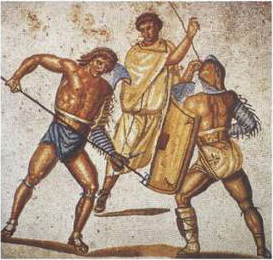
I was at Ephesus last week and they were setting up some mysterious stands along the harbor road. Turns out it was a 'reenactment' of 'ancient Ephesus'.

These guys were supposed to be 'gladiators', though those look more like Roman military uniforms to me. Note the total lack of beefcake compared to the real thing:

They looked like they were having fun anyway, even if the swordplay wasn't overwhelming. There was also some interpretative dance. I'm not entirely sure why anyone would pick these colors for anything historical, since before the invention of aniline dyes after 1856 such bright colors would have been impossible, or extremely expensive, to create.

The whole thing was supervised by "Caesar" and "Cleopatra", dressed in grape juice purple. While I'm on color, another one of my pet peeves is that the Imperial 'Purple' was really more of a scarlet with some pink in it, but everyone goes with this grape candy color.

I can be catty about this stuff at times, but I thought the trumpeters did look pretty fly standing on the ancient wall.

The whole production, I found out later, is staged for the benefit of passengers on Norwegian Cruise Line, which disgorges its thousands onto buses and dumps them at Ephesus for a couple hours.

Turkey is experimenting with renting out archaeological sites for events like this, a development which I'm totally neutral about generally. I mean, there's a ton of ancient cities and theaters and stuff that if used right can add a lot to both the tourist economy and cultural life (the most famous in these parts being the Aspendos Festival). Like in anything commercial, however, quality control is pretty key, and that's the worrisome part when delicate ancient ruins are in question.



I love everything about this post from the appropriately-placed quotation marks, re-corrective color thoughts, use of the word disgorge, and fair assessment of archaeological sites as tourist hotspots. And rest assured, on this subject, you are far less catty than I or other members of the Ephesos excavation team - who by the way, you should try hitching a ride with in the early morn' to experience unadulterated Ephesos.
ReplyDeleteThanks Leah! I'll try to take your advice, I should be going back sometime soon...
ReplyDeleteLet me take the opportunity to ask an archaeological question about Ephesus. I have heard that the hills overlooking the reconstructed civic architecture were the locations of commoner housing, probably on terraces. Is this the case? If so, is anything known about these houses? I reviewed some of the publications on the site recently and could not find anything about this (I'm not talking about the "Terrace houses"). Any suggestions would be appreciated. For the origin of my interest, see:
ReplyDeletehttp://calixtlahuaca.blogspot.com/2009/10/why-build-city-on-mountain.html
And also, this is a great blog. Last semester I put on some of the video clips at the start of my class on ancient cities, while students were arriving and settling in.
Hi Michael - thanks for the kind words! I think it's more or less correct that the residential areas crept up the hillsides, which is not unusual in Anatolia. What IS unusual is for anyone to bother excavating domestic architecture when there's all kinds of nice marble monuments to drool over. It remains a very under-studied area in the Roman Mediterranean. The investigation of ancient urban neighborhoods that I've heard most about in Turkey are largely through remote sensing: see
ReplyDeletehttp://www.oeai.at/eng/ausland/oberst.html
for the project at Ephesus. For similar research at Sagalassos, see
http://sagalassos.be/en/monuments_sites/outside_city_walls/eastern_residential_area
and
http://sagalassos.be/en/monuments_sites/outside_city_walls/western_residential_area
Hope this helps! Sounds like interesting research you're doing, I like your blog.
This book might also be helpful, it rounds up a lot of recent research from the Late Antique period:
ReplyDeletehttp://www.amazon.com/gp/search?index=books&linkCode=qs&keywords=9004162283
Thanks for the links. Sorry about the delay, I guess I thought I would get notifications of comments. Both of these sites should have good information soon for our comparative neighborhoods project:
ReplyDeletehttp://cities.asu.edu/